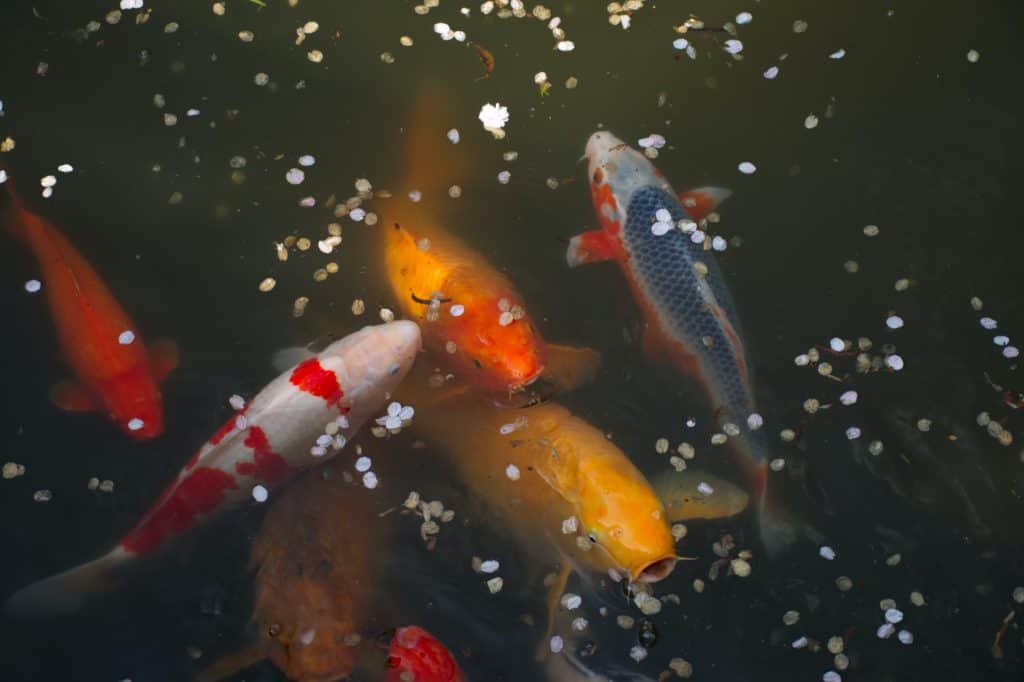There are many myths about the longevity of koi. Some rumors place the oldest koi around 250 years old! Although this is not substantiated, koi are certainly built to live a very long time. Learn how long koi live and plan for their entire lives in your pond.
Depending on their lineage and breeding practices, most koi can be expected to live 40-60 years easily. Our service has only occasionally seen a fish 30 years or older. Do you want to know the most common cause of death in older fish? The owner leaves the hose on, causing a chlorine toxicity and killing their fish, usually starting with the largest, and typically, oldest fish.
How can I setup my koi up for a long, healthy life?
Step 1: Good filtration and water quality is essential to healthy koi lives.
As we have said many, many, many times before, water quality is the #1 influence on fish health.
Step 2: Resist the urge to overstock your pond.
We understand that when koi are young, they are very small. It is hard to picture that cute 4-6” fish growing into a >24” giant. But they could get that big. It is recommended that every koi has 250 gallons of water to call their own, and this increases to 500 gallons for pregnant females. Most koi owners will calculate this water to fish ratio and be well over their mark. We know this to be the case. If you can build a bigger pond, great, but not likely. And we’re not suggesting you kill off a certain portion of your fish, just be aware you are overstocked and will likely have a filtration or space crunch in the future.
Step 3: Stop buying more fish.
New fish is the #2 cause of disease in koi ponds second only to poor water quality. Most koi owners are not setup for a proper quarantine and the pet or koi stores protocols vary significantly. Almost all of our koi owners are trying to find that last “perfect” fish to complete their collection. We strongly recommend you resist the urge. It’ll cut down on how hard your filtration has to work, how much space your fish have and chance of disease getting into your pond.
Step 4: Practice mindful maintenance.
Remember the #1 cause of death in older fish? Someone leaves the hose on. Back when I worked at the aquarium, it was expected of everyone to overflow some system at some point of their career. Thankfully, mine happened in our quarantine area where no one saw it and the floor drains easily cleaned it up. From then on, whenever I was filling a tank, I took my hair down and put the rubber band around my wrist. When you’re all gross and sweaty and hate things around your wrist, it is very hard to ignore that reminder.
Pick something that works for you and practice it consistently, no matter how many times you think, “oh, I won’t forget I’m filling the pond.” Set a reminder on your phone, read a book while you babysit your filling, or set an obnoxious cue, like a tight rubber band on your finger or wrist.
Step 5: Schedule regular checkups with your aquatic veterinarian.
Preventative medicine is critical for long life in any animal, yourself included. Why do you think your doctor recommends a yearly physical and cancer screenings? Because if they catch something early, the chances of having successful treatment increases. By getting your fish a yearly or biyearly checkup, your veterinarian can catch health issues earlier and treat them, cancers included. Does it cost money? Of course!
As with all healthcare, you get what you pay for. Your neighbor who took a weekend koi course and offers to evaluate your fish for free will never be able to give you the results of a trained, qualified aquatic veterinarian. Yes, we exist. Can they ultrasound your fish and screen them for cancer? We can. If you can’t find anyone near you, your local veterinarian of any specialty will be able to consult with us. We are happy to teach any veterinarian how to see fish.
Follow these steps and your koi will be well set up for a long, healthy, happy life!



Most of the new koi fish keepers even old koi fish keepers mistakes is not guaranteeing their new koi fish